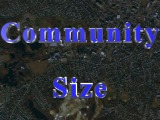Community of 7000
...the MOSAIC OF SUBCULTURES (8) is made up of a great number
of large and small self-governing communities and
neighborhoods. Community Of 7000 helps define the structure
of the large communities.
Individuals have no effective voice in any community of more
than 5000-10,000 persons.
People can only have a genuine effect on local government when
the units of local government are autonomous, self-governing,
self-budgeting communities, which are small enough to create
the possibility of an immediate link between the man in the
street and his local officials and elected
representatives.
This is an old idea. It was the model for Athenian democracy
in the third and fourth centuries B.C.; it was Jefferson's
plan for American democracy; it was the tack Confucius took in
his book on government, The Great Digest.
For these people, the practice of exercising power over local
matters was itself an experience of intrinsic satisfaction.
Sophocles wrote that life would be unbearable were it not for
the freedom to initiate action in a small community. And it
was considered that this experience was not only good in
itself, but was the only way of governing that would not lead
to corruption. Jefferson wanted to spread out the power not
because "the people" were so bright and clever, but precisely
because they were prone to error, and it was therefore
dangerous to vest power in the hands of a few who would
inevitably make big mistakes. "Break the country into wards"
was his campaign slogan, so that the mistakes will be
manageable and people will get practice and improve.
Today the distance between people and the centers of power
that govern them is vast-both psychologically and
geographically. Milton Kotler, a Jeffersonian, has described
the experience:
"The process of city administration is invisible to the
citizen who sees little evidence of its human components
but feels the sharp pain of taxation. With increasingly
poor public service, his desires and needs are more
insistently expressed. Yet his expressions of need seem
to issue into thin air, for government does not appear
attentive to his demands. This disjunction between
citizen and government is the major political problem of
city government, because it embodies the dynamics of civil
disorder... (Milton Kotler, Neighborhood Foundations,
Memorandum #24; "Neighborhood corporations and the
reorganization of city government," unpub. ins., August
1967.)
There are two ways in which the physical environment, as it is
now ordered, promotes and sustains the separation between
citizens and their government. First, the size of the
political community is so large that its members are separated
from its leaders simply by their number. Second, government
is invisible, physically located out of the realm of most
citizens' daily lives. Unless these two conditions are
altered, political alienation is not likely to be overcome.
The size of the political community.
It is obvious that the larger the community the greater the
distance between the average citizen and the heads of
government. Paul Goodman has proposed a rule of thumb, based
on cities like Athens in their prime, that no citizen be more
than two friends away from the highest member of the local
unit. Assume that everyone knows about 12 people in his local
community. Using this notion and Goodman's rule we can see
that an optimum size for a political community would be about
123 or 1728 households or 5500 persons. This
figure corresponds to an old Chicago school estimate of 5000.
And it is the same order of magnitude as the size of ECCO, the
neighborhood corporation in Columbus, Ohio, of 6000 to 7000,
described by Kotler (Committee on Government Operations, U.S.
Senate, 89th Congress, Second Session, Part 9, December 1966).
The editors of The Ecologist have a similar intuition about
the proper size for units of local government. (See their
Blueprint for Survival, Penguin Books, 1972, pp. 50-55.) And
Terence Lee, in his study, "Urban neighborhood as a
socio-spatial schema," Ekistics 177, August 1970, gives
evidence for the importance of the spatial community. Lee
gives 75 acres as a natural size for a community. At 25
persons per acre, such a community would accommodate Some 2000
persons; at 60 persons per acre, some 4500.
The visible location of local government.
Even when local branches of government are decentralized in
function, they are often still centralized in space, hidden in
vast municipal city/county buildings out of the realm of
everyday life. These places are intimidating and alienating.
What is needed is for every person to feel at home in the
place of his local government with his ideas and complaints.
A person must feel that it is a forum, that it is his
directly, that he can call and talk to the person in charge of
such and such, and see him personally within a day or two.
For this purpose, local forums must be situated in highly
visible and accessible places. They could, for instance, be
located in the most active marketplace of each community of
5000 to 7000. discuss this possibility more fully under LOCAL
TOWN HALL (44), but we emphasize it here, since the provision
of a political "heart," a political center of gravity, is an
essential part of a political community.
Source: A Pattern Language: Towns, Buildings, Construction
Christopher Alexander, et. al.
Oxford University Press
New York, 1977
pp 71-73

